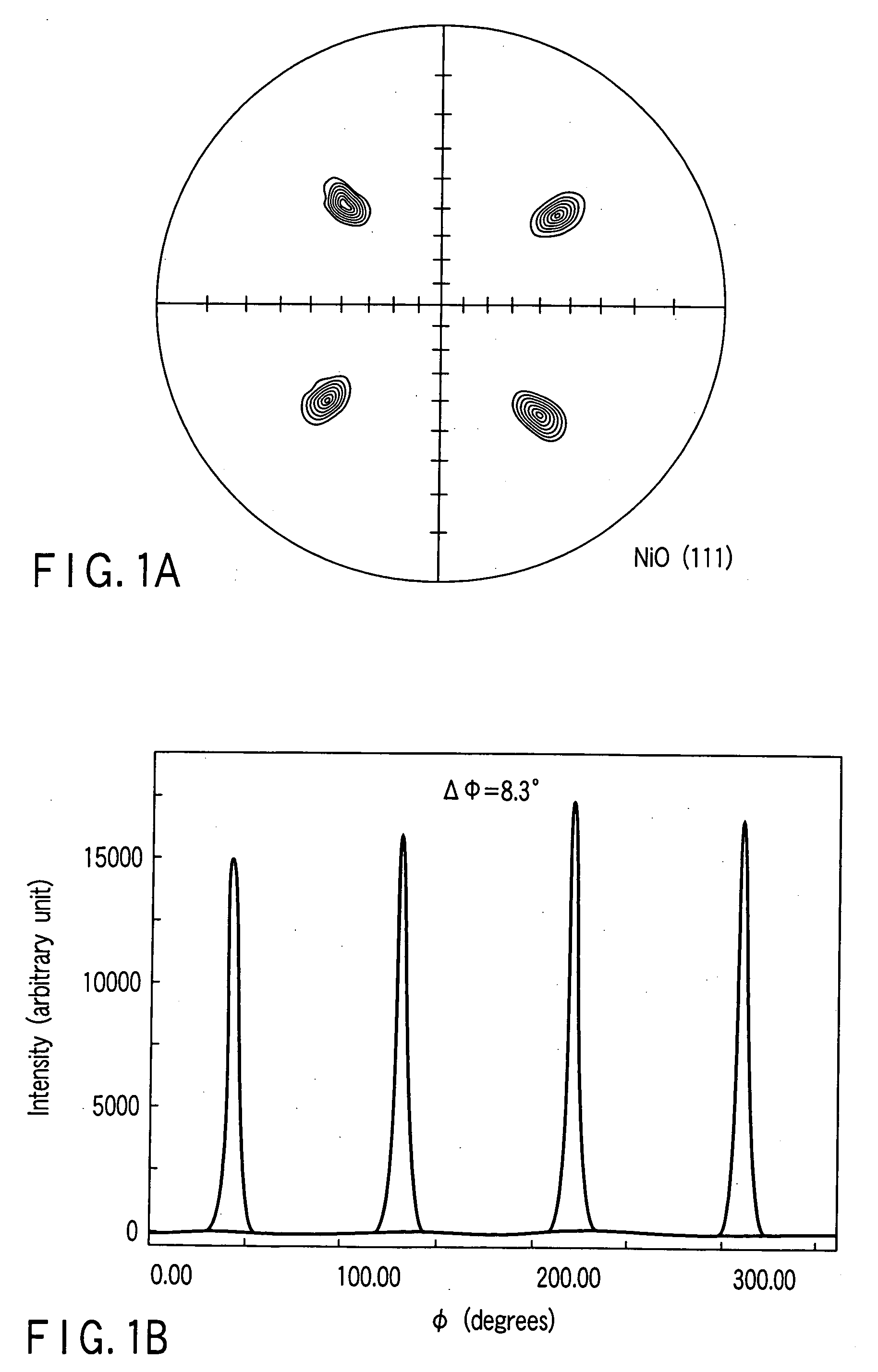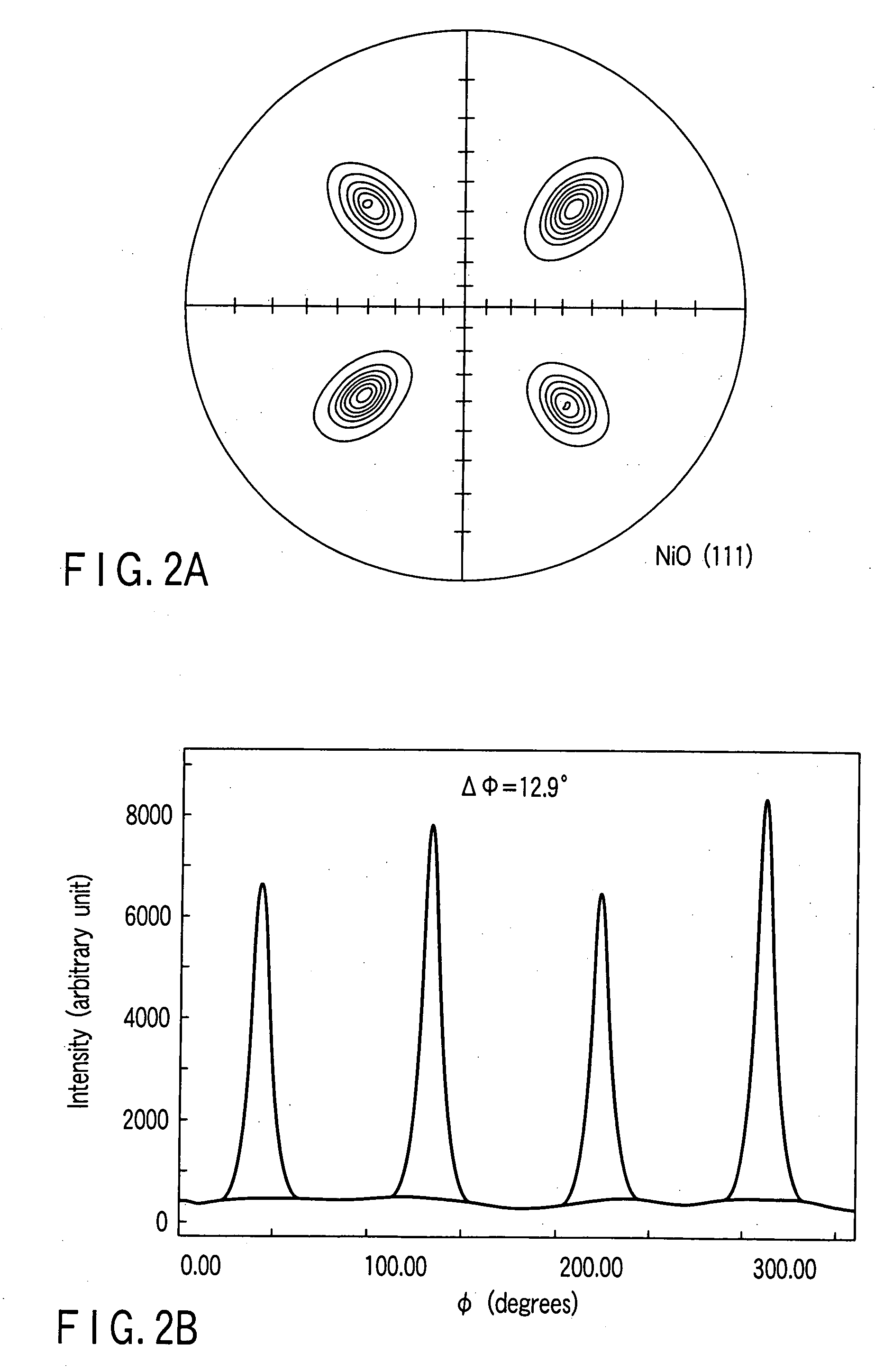Metal substrate for an oxide superconducting wire, oxide superconducting wire and manufacturing method of the same
a technology of metal substrate and oxide superconducting wire, which is applied in the direction of superconductors/hyperconductors, electrical devices, superconductors/hyperconductors, etc., can solve the problems of not taking into account the enhancement of orientation of oxide crystals at all, failing to obtain satisfactory critical current density, and slow forming rate, etc. , to achieve excellent orientation and excellent critical current density , the effect of excellent orientation
- Summary
- Abstract
- Description
- Claims
- Application Information
AI Technical Summary
Benefits of technology
Problems solved by technology
Method used
Image
Examples
example 1
[0054] A polycrystalline nickel substrate having a rolled aggregate structure having a {100} plane which is parallel to the rolled surface and a axis which is parallel to the rolling direction was prepared. This substrate was placed in a heating furnace and subjected to a first heat treatment for 20 hours at a temperature of 750° C. and in an atmosphere containing a minute quantity of oxidizing gas created by continuously evacuating the heating furnace while introducing argon gas therein. Incidentally, when an average film-forming speed of this first heat treatment was measured, it was 0.15 μm / hr.
[0055] Although an NiO layer excellent in orientation was already formed at this stage, the thickness thereof was as thin as not more than 3 μm, so that it was most probable that the NiO layer would be vanished as the surface thereof was polished. Therefore, in order to secure the thickness of the NiO layer, a second stage heat treatment was performed as follows.
[0056] Namely, the polycr...
example 2
[0060] A polycrystalline nickel substrate having a rolled aggregate structure having a {100} plane which is parallel to the rolled surface and a axis which is parallel to the rolling direction was prepared. This substrate was placed in a heating furnace and subjected to a first heat treatment for one hour at a temperature of 1100° C. and in an atmosphere containing a minute quantity of oxidizing gas created by continuously evacuating the heating furnace while introducing argon gas therein.
[0061] Although an NiO layer excellent in orientation was already formed at this stage, the thickness thereof was as thin as not more than 1 μm, so that it was most probable that the NiO layer would be vanished as the surface thereof was polished. Therefore, in order to secure the thickness of the NiO layer, a second stage heat treatment was performed as follows.
[0062] Namely, the polycrystalline nickel substrate having a thin NiO film formed thereon by the first heat treatment was further subje...
example 3
[0068] The surface of the substrate obtained in Example 1 was buffed to obtain a polished surface on which a BaZrO3 film was formed as a diffusion barrier layer by means of laser abrasion using KrF excimer laser. The deposition of the BaZrO3 film was performed in an Ar gas atmosphere of 20 mm Torr in pressure with the repeating frequency of laser being set to the range of 10-20 Hz and the temperature of the substrate being controlled to 600-700° C.
[0069] On this diffusion barrier layer formed in this manner, a Y123 oxide superconductor layer was formed by means of laser abrasion. The deposition of the Y123 oxide superconductor layer was performed in an O2 gas atmosphere of 100-200 mm Torr in pressure with the repeating frequency of laser being set to the range of 10-20 Hz and the temperature of the substrate being controlled to 700-800° C.
[0070] On this Y123 oxide superconductor layer was further deposited a Y—Yb123 oxide superconductor layer by means of liquid phase epitaxy. More...
PUM
| Property | Measurement | Unit |
|---|---|---|
| angle | aaaaa | aaaaa |
| temperature | aaaaa | aaaaa |
| temperature | aaaaa | aaaaa |
Abstract
Description
Claims
Application Information
 Login to View More
Login to View More - R&D
- Intellectual Property
- Life Sciences
- Materials
- Tech Scout
- Unparalleled Data Quality
- Higher Quality Content
- 60% Fewer Hallucinations
Browse by: Latest US Patents, China's latest patents, Technical Efficacy Thesaurus, Application Domain, Technology Topic, Popular Technical Reports.
© 2025 PatSnap. All rights reserved.Legal|Privacy policy|Modern Slavery Act Transparency Statement|Sitemap|About US| Contact US: help@patsnap.com



